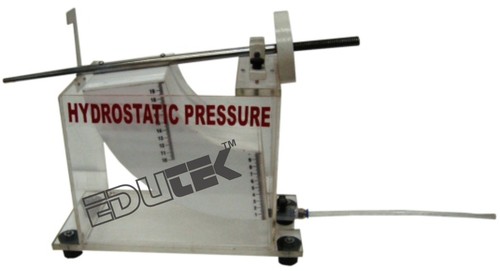Hydrostatic Pressure In Liquids
Product Details:
X
Product Description
HYDROSTATIC PRESSURE IN LIQUIDS
The weight of fluids at rest causes a pressure that is known as hydrostatic pressure or gravitational pressure. This pressure acts on any area that is in communication with the fluid, exerting a force that is proportional to the size of the area.
The effect of hydrostatic pressure is highly important in many fields of engineering: in shipbuilding, in hydraulic engineering when designing locks and weirs, in sanitation and building services.
The experimental unit offers typical experiments to study hydrostatic pressure in liquids at rest. The effect of the hydrostatic pressure of water can be clearly shown at different water levels and angles of inclination.
The experimental unit consists of a transparent, tilting water tank with a scale for measuring volumes. Another scale is used to adjust the angle of inclination of the water tank. The device is balanced by a lever arm using different weights and the compressive force measured.
The well-structured instructional material sets out the fundamentals and provides a step-by-step guide through the experiments.
Learning Objectives / Experiments
- Pressure distribution along an effective area in a liquid at rest
- Lateral force of the hydrostatic pressure
- Determination of the centre of pressure and centre of area
- Determination of the resulting compressive force
Specification:
- Investigation of the hydrostatic pressure in fluids at rest
- Tiltable water tank with fill level scale
- Lever arm with different weights
Technical Data:
- Water tank
- Inclination angle: 0°...90°
- Content: 0...1,8L
- Scale: 0...250mm
- Effective area, max. 75x100mm
Lever arm:
- Max. length 250mm
Weights:
- 1x 2,5N
- 1x 2N
- 2x 1N
- 1x 0,5N
Dimensions and Weight:
- LxWxH: 410x520x425 mm
- Weight: approx. 10kg
Tell us about your requirement

Price:
Quantity
Select Unit
- 50
- 100
- 200
- 250
- 500
- 1000+
Additional detail
+91
Email
Other Products in 'Fluid Mechanics Lab Equipment' category
"We deal all over World but our main domestic market is South India"
 |
EDUTEK INSTRUMENTATION
All Rights Reserved.(Terms of Use) Developed and Managed by Infocom Network Private Limited. |














